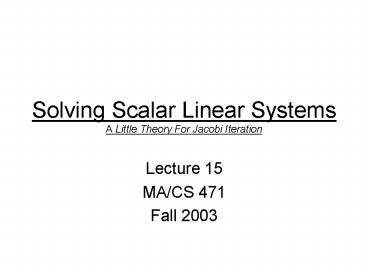Solving Scalar Linear Systems A Little Theory For Jacobi Iteration - PowerPoint PPT Presentation
1 / 19
Title:
Solving Scalar Linear Systems A Little Theory For Jacobi Iteration
Description:
The equation we wish to solve is: We consider the following iterator: ... Thirdly, we showed that for the choice of. Q = diagonal of A, that (2) was satisfied. ... – PowerPoint PPT presentation
Number of Views:88
Avg rating:3.0/5.0
Title: Solving Scalar Linear Systems A Little Theory For Jacobi Iteration
1
Solving Scalar Linear Systems A Little Theory
For Jacobi Iteration
- Lecture 15
- MA/CS 471
- Fall 2003
2
Review
- Using Kirchoffs second law we build the loop
current circuit matrix.
3
1W
4W
4W
6W
-
5
2
4
3W
V4
7W
2W
1W
1
-
V1
Note we have boosted the center cell to ensure
diagonal dominance (hack)
3
System
Jacobi iterative approach
4
Jacobi v. Gauss-Seidel
Jacobi
Gauss-Seidel
5
Convergence Proof
6
Definition of Spectral Radius
- We define the spectral radius of a matrix A as
7
Stage 1 Unique Limit
- The equation we wish to solve is
- We consider the following iterator
- For some easily invertible matrix Q
- Suppose this iteration does indeed converge as
, i.e. - Then xtilde will satisfy
8
cont
- And yields
- So if the iteration converges, then the limit
vector will be a solution to the original system.
9
Second Stage of Convergence Proof
- We first prove that the Jacobi (and Gauss-Seidel)
methods converge if and only if the spectral
radius of
10
Theorem
- Suppose and
that both Q and A are non-singular. If the
spectral radius of is
strictly bounded above by 1 then the iterates
defined by - converge to for any starting vector
11
Proof
- Let denote the error in the nth
iterate. We combine the following
relationships - to obtain
- simplifying
12
Proof cont
- The iteration converges with
increasing n if and only if (proof
omitted).
13
Third Stage of Convergence
- Now we are left with the task of proving that for
the choice of Q the matrix has - i.e. we have to prove that the absolute value of
all of the eigenvalues of the matrix is less
than one. - So we use Gershgorins theorem to find the range
of the eigenvalues of
14
Recall Gershgorins Circle Theorem
- Let A be a square NxN matrix. Around every
element - aii on the diagonal of the matrix draw a circle
with - radius
- Such circles are known as Gershgorins disks.
- Theorem every eigenvalue of A lies in one of
these Gershgorins disks.
15
Jacobi Iteration
- Recall the generic iterative scheme required a Q
matrix which is easily invertible. - Lets take Qdiag(A) (i.e. a matrix with zeros
everywhere, apart from the diagonal entries which
are the same as those of A) - Lets write ALDU
D
U
L
16
Cont.
- Then the scheme becomes
- i.e.
- We can determine conditions under which this
scheme will converge. - Recall the necessary and sufficient condition that
17
Cont.
- We can use Gershgorins theorem after we note
that - has zero entries on the diagonal so all the
Gershgorin disks will be centered at zero and
have maximum radius
18
cont
- So if
- Then we are done.
- Note, a matrix which satisfies
- Is called diagonally dominant.
19
Summary
- The first stage of the convergence proof showed
that the unique possible convergent limit of the
scheme is the actual solution to the linear
system. - Secondly, we showed that the scheme converges if
and only if - Thirdly, we showed that for the choice of Q
diagonal of A, that (2) was satisfied. - i.e. Jacobi iteration converges for any initial
guess for x if A is diagonally dominant.































